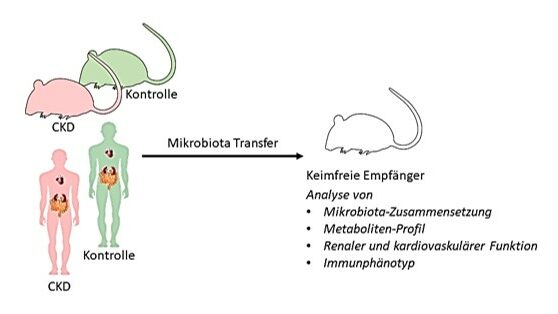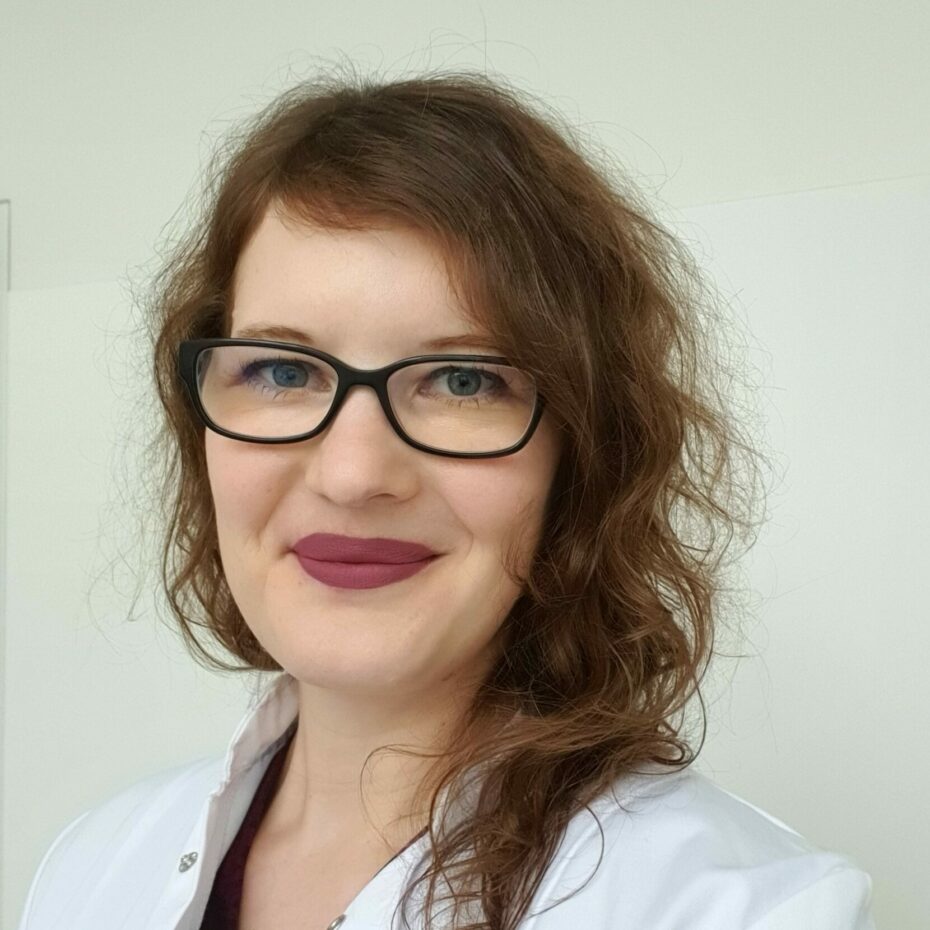Crosstalk between intestinal macrophages and innate lymphoid cells
Scientific interest within the context of the graduate college:
Our research aims to understand the role of tissue-resident cells of the innate immune system in the prevention of chronic inflammatory diseases such as systemic lupus erythematosus and inflammatory bowel disease. Our goal is to identify mechanisms that may inhibit the transition from homeostasis to chronic inflammatory disease and to determine the role of tissue-resident cells of the innate immune system in this process. Understanding such mechanisms may allow to answer the question of why some patients are susceptible to chronic autoimmune-related inflammatory diseases and others are not, and how to improve/achieve resistance to chronic inflammatory diseases.
Project description:
The overarching goal of our research is to better understand the role of tissue-derived cells of the innate immune system in the prevention of chronic inflammatory diseases. Our specific objective is to identify mechanisms that can inhibit the transition from homeostasis to chronic inflammatory diseases. A comprehensive understanding of these mechanisms could help to clarify why certain patients are more susceptible to chronic inflammatory diseases than others. Furthermore, we want to understand how resistance to chronic inflammatory diseases can be improved or achieved.
Mechanosensing in macrophages in health and disease
Scientific interest within the context of the graduate college:
Our lab is interested in analyzing immune cells in the tissue context, using state-of-the-art, functional intravital microscopy and histocytometry approaches.1,2,3 In addition to reacting to stimuli from hematopoietic and non-hematopoietic cells, for example via direct cell-cell contacts or via soluble mediators, immune cells are exposed to a variety of other stimuli present in the tissue, among them mechanical cues. The significance of those stimuli for immune cells has not been explored in detail. Recently, a role for the mechanosensor Piezo1 in shaping myeloid cell activation has been identified.4 Here, we aim to understand how mechanical cues in barrier tissues affect the function of myeloid cells. We will focus the lamina propria of the intestine, a tissue that in the healthy organism is constantly subjected to contractions (peristalsis). We hypothesize that this mechanical stimulation impacts on the phenotype of macrophages in the lamina propria. As alterations in peristalsis appear in certain situations, such as parasitic infections, we aim to test to what extent mechanosensing in macrophages affects their function under those conditions.
Project description:
To monitor mechanosensing in vivo, we aim to use a reporter system, which allows for the detection of Ca2+ flux, induced by the mechanosensor Piezo1, in intestinal macrophages by intravital microscopy.5 The objectives for this project are:
Aim 1: Determine the effect of mechanical stimuli on the phenotype of macrophages in vitro. Myeloid cells will be cultured and various, defined mechanical stimuli will be applied in a specialized chamber. The phenotypes of the cells will be compared by flow cytometry.
Aim 2: Define the role of the Ca2+ channel Piezo1 in myeloid mechanosensing and establish a reporter system for the quantification of Piezo1-mediated Ca2+ flux in vitro and in vivo. The impact of Piezo1 stimulation on cytoplasmic Ca2+ concentration will be assessed using specific inhibitors/activators in vitro. To quantify Piezo1-induced Ca2+ flux in the cytoplasm in vivo, we plan to use mice carrying a genetically encoded cytoplasmic calcium sensor in macrophages. We will relate the sensor signals to mechanical stimuli in vitro. Subsequently, we aim to employ this system to locate and quantify mechanically induced Ca2+ flux in myeloid cells by intravital FRET-FLIM microscopy,6 and correlate this signal to tissue dynamics, to map the pressure conditions in vivo.
Aim 3: Determine to what extent Piezo1-mediated mechanosensing in myeloid cells of the lamina propria contributes to the intestinal immune response in vivo. The phenotype of intestinal macrophages will be compared by flow cytometry and multiplexed histology in mice with a deficiency of Piezo1 in myeloid cells to wildtype mice. Initial analyses will be performed under homeostatic conditions. Subsequently, we will challenge the mice by infecting them with intestinal parasites, which are known to mechanically impact on the tissue, either by attaching to the intestinal wall or by inducing altered gut peristalsis.
References
- Pascual-Reguant A, Kohler R, Mothes R, Bauherr S, Uecker R, Holzwarth K, Kotsch K, Seidl M, Philipsen L, Müller W, Hernández D, Romagnani C, Niesner R, Hauser AE. Phenotypic and spatial characteristics of human Innate Lymphoid Cells revealed by highly multiplexed histology. Nat Commun. 2021. Accepted for publication.
- Stefanowski J, Lang A, Rauch A, Aulich L, Kohler M, Fiedler AF, Buttgereit F, Schmidt-Bleek K, Duda GN, Gaber T, Niesner RA, Hauser AE. Spatial Distribution of Macrophages During Callus Formation and Maturation Reveals Close Crosstalk Between Macrophages and Newly Forming Vessels. Front Immunol. 2019;10: 2588. doi: 10.3389/fimmu.2019.02588.
- Holzwarth K, Kohler R, Philipsen L, Tokoyoda K, Ladyhina V, Wahlby C, Niesner RA, Hauser AE. Multiplexed fluorescence microscopy reveals heterogeneity among stromal cells in mouse bone marrow sections. Cytometry A. 2018;93: 876-888. doi: 10.1002/cyto.a.23526.
- Solis AG, Bielecki P, Steach HR, Sharma L, Harman CCD, Yun S, de Zoete MR, Warnock JN, To SDF, York AG, Mack M, Schwartz MA, Dela Cruz CS, Palm NW, Jackson J, Flavell RA. Mechanosensation of cyclical force by PIEZO1 is essential for innate immunity. Nature. 2019; 573: 69-74. doi: 10.1038/s41586-019-1485-8.
- Lindquist RL, Bayat-Sarmadi J, Leben R, Niesner R, Hauser AE. NAD(P)H Oxidase Activity in the Small Intestine Is Predominantly Found in Enterocytes, Not Professional Phagocytes. Int J Mol Sciences. 2018; 19:1365. doi: 10.3390/ijms19051365.
- Ulbricht C, Leben R, Rakhymzhan A, Kirchhoff F, Nitschke L, Radbruch H, Niesner RA, Hauser AE. Intravital quantification of absolute cytoplasmic B cell calcium reveals dynamic signaling across B cell differentiation stages. Elife. 2020; 10:e56020. doi: 10.7554/eLife.56020.
Immunophenotyping in bullous pemphigoid to identify new therapeutic targets
Scientific interest within the context of the graduate college:
Our laboratory focuses on the immunological and molecular pathomechanisms of the skin with the aim to identify approaches for personalized and preventive medicine. One group of our translational research interests are chronic inflammatory autoimmune diseases of the skin. In addition to preclinical models and in vitro methods, we use skin and blood samples from patients for biomarker identification. We are particularly interested in specialized T cell responses and cytokine signaling pathways (JAK/STAT).
Project description:
Blistering autoimmune dermatoses (bAD) represent a heterogeneous group of skin diseases characterized by autoantibodies against structural proteins. In pemphigoid diseases, the formation of IgG and, more rarely, IgA/IgM antibodies against hemi desmosomes lead to loss of contact of the lower keratinocyte layer with the basal membrane. Subepidermal cleft formation occurs, resulting in the formation of blisters.1 The most common pemphigoid disease of old age is bullous pemphigoid (7/8 LD), followed by rarer variants such as lamin γ1 and scarring mucinous pemphigoid. While B cells are primarily responsible for autoantibody production, T cells appear to play an important role in disease development.
In recent work on the pathogenesis of bAD, we were able to investigate the relationship between specialized T follicular helper (Tfh) cells and autoreactive B cells for the production of autoantibodies in bAD by comprehensive analyses of the immune system (RNA-seq, immunoprofiling, T/B cell cultures).2 In bullous pemphigoid, the risk of disease increases with age without knowing the immunological precursors for this. In this project, we aim to clarify whether specialized Tfh cells and their cytokines differ in healthy individuals and bAD patients in an age-dependent manner. The aim is to investigate their influence on the pathogenesis of the disease and to identify new markers to predict the risk for the manifestation of bAD or even to use them preventively.3
In this project, Tfh populations of peripheral blood will be studied by multiparametric flow cytometry. We are particularly interested in the differences between healthy and bAD patients and the changes in different age decades. Furthermore, the cytokine profile (IL-4, IL-17, IL-21, IL-6, IFN-y) will be investigated.4 These results will be compared on the one hand with antibody titers against BP180 and BP230 and on the other hand with transcriptome analyses of healthy and lesional skin (bAD). The goal of the PhD thesis is to determine disease-associated patterns relevant for early detection or risk of manifestation of bAD, by evaluating the Tfh populations, cytokine profile, autoantibody titers, and age-related parameters.
References
- Schmidt E, Kasperkiewicz M, Joly P. Pemphigus. Lancet. 2019; 394(10201):882-894. doi: 10.1016/S0140-6736(19)31778-7.
- Holstein J, Solimani F, Baum C, […], Pfützner W, Ghoreschi K, Möbs C. Immunophenotyping in pemphigus reveals a TH17/TFH17 cell-dominated immune response promoting desmoglein1/3-specific autoantibody production. J Allergy Clin Immunol. 2020: S0091-6749(20)31624-9. doi: 10.1016/j.jaci.2020.11.008. Epub ahead of print.
- Eckardt J, Eberle FC, Ghoreschi K. Diagnostic value of autoantibody titres in patients with bullous pemphigoid. Eur J Dermatol. 2018; 28(1):3-12. doi: 10.1684/ejd.2017.3166.
- Li Q, Liu Z, Dang E, […], Yang L, Shi X, Wang G. Follicular helper T Cells (Tfh) and IL-21 involvement in the pathogenesis of bullous pemphigoid. PLoS One. 2013; 8(7):e68145. doi: 10.1371/journal.pone.0068145
Group 3 Innate Lymphoid Cells as regulators of intestinal organ hypertrophy in response to increased metabolic demands during pregnancy and lactation
Scientific interest within the context of the graduate college:
We study development and function of the innate immune system, in particular of innate lymphoid cells (ILC). A current focus is to obtain a molecular understanding of how the innate immune system, by integrating environmental signals, contributes to tissue physiology and health. Recent studies have revealed ever more intriguing relationships between innate immune system components and basic developmental and biologic processes that are likely to reveal unsuspected pathways by which the immune system might be plumbed to improve health and health span. These lines of research have suggested new functions of the immune system for processes such as tissue homeostasis, morphogenesis, metabolism, regeneration and growth. Our research is developing by crossing boundaries of disciplines (immunology, microbiology, developmental biology, stem cell biology, nutrition sciences, tumor biology, regenerative medicine etc.) and is, by nature, highly interdisciplinary.
Project description:
Based on our data, we hypothesize that ILC3 play an important role in directly instructing adaptation of the intestinal organ to changing metabolic needs by affecting programs in epithelial stem cells or their immediate progeny. Available data has interrogated the role of ILC3: stem cell modules in the context of intestinal damage. We wondered if ILC3 are involved in more physiological adaptative processes. One of the biggest challenges to metabolic demands in life is pregnancy. During gestation and lactation, the female organism undergoes major physiological changes to accommodate the developing offspring prominent among them considerable growth of the crypt-villus axis of the small intestine. We have recently developed a sophisticated method to record crypt-villus length and noted that mice lacking ILC3 (i.e., Rorc(gt)Gfp/Gfp mice) do not show pregnancy and lactation-induced epithelial hypertrophy. Interestingly, such absence of intestinal growth led to reduced caloric absorption by enterocytes and reduced caloric content of breast milk.
We hypothesize that ILC3 act on intestinal stem cells enhancing differentiation of enterocytes for increased nutrient absorption. Our research may provide a novel conceptual framework of how tissue and metabolic adaptation can be sustained by ILC3 that may dynamically adjust epithelial cell function to a variety of physiological demands.
Our major goals are (1) to define the role of ILC3 in pregnancy and lactation-induced epithelial hypertrophy on a molecular level, (2) to analyze the impact of ILC3 on stem cell representation, niche population dynamics using stochastic multi-color fate labelling, and (3) to understand how ILC3 regulate epithelial cell metabolism and tissue growth during pregnancy and lactation.
References
- Guendel F, Kofoed-Branzk M, Gronke K, […], Mashreghi MF, Kruglov AA, Diefenbach A. Group 3 innate lymphoid cells program a distinct subset of IL-22BP-producing dendritic cells demarcating solitary intestinal lymphoid tissues. Immunity. 2020; 53:1015-1032. doi: 10.1016/j.immuni.2020.10.012.
- Schaupp L, Muth S, Rogell L, […],Schild H, Diefenbach A1,*,Probst HC*. Microbiota-induced tonic type I interferons instruct a poised basal state of dendritic cells. Cell. 2020; 181:1080-1096. doi: 10.1016/j.cell.2020.04.022. 1Lead Senior Author; *equal contribution.
- Gronke K, Hernández PP, Zimmermann J, […], Glatt H, Triantafyllopoulou A, Diefenbach A. Interleukin-22 protects intestinal stem cells against genotoxic stress. Nature. 2019; 566:249-253. doi: 10.1038/s41586-019-0899-7.
- Klose CSN, Flach M, Möhle L, […], Dunay IR, Tanriver Y, Diefenbach A. Differentiation of type 1 ILCs from a common progenitor to helper-like innate lymhoid cell lineages. Cell. 2014; 157:340-356. doi: 10.1016/j.cell.2014.03.030.
- Klose CSN, Kiss EA, Schwierzeck V, […], Waisman A, Tanriver Y, Diefenbach A. A T-bet gradient controls the fate and function of CCR6– RORγt+ innate lymphoid cells. Nature. 2013, 494:261-265. doi: 10.1038/nature11813.
Impact of the microbiome and the immune system on cardiovascular risk in chronic kidney disease
Scientific interest within the context of the graduate college:
Our laboratory investigates the interaction of dietary factors with the gut microbiota and the host, especially with the host’s immune system, in the context of cardiovascular and renal disease.1-4 Arterial hypertension and chronic kidney disease (CKD) are of particular interest, as both conditions are associated with a significantly increased cardiovascular risk. We combine experimental model systems with exploratory clinical studies to better understand the microbiota-host interaction. We aim to use our findings to further define health in this context and to better understand transitions to disease.
CKD is associated with dysregulated immune responses5 and high cardiovascular risk.6 In addition, CKD is associated with changes in the composition and function of the microbiota. Indole metabolites of bacterial origin are of particular interest here, as they can accumulate in the blood with declining renal function and have an immunomodulatory potential.3 It is unclear to what extent these CKD-associated microbial changes contribute to cardiovascular risk. To investigate this question, microbiota from CKD patients, as well as from CKD mouse models and healthy control groups will be transplanted into germ-free mice. In the recipients, immunological changes and cardiovascular parameters will be quantified and the molecular mechanisms involved will be investigated in more detail.
Project description:
WP 1: Microbiota transfer from CKD mouse models. Fecal samples from different CKD animal models (incl. healthy controls) will be analyzed (composition, metabolites) and used to colonize germ-free mice. The recipients will then be phenotyped in regard to their immune function (isolation of immune cells from different end organs and analysis by flow cytometry) and cardiovascular function (vascular and cardiac function, intestinal barrier, etc.) and compared with parameters of the donors.
WP2: Microbiota transfer of human-associated microbiota. Stool samples from CKD patients and healthy controls will be collected, analyzed by sequencing (composition, metabolites), and transplanted into germ-free mice (Fig. 1). Immunological, microbial, and cardiovascular parameters will be analyzed between the two groups of recipients and the extent to which human CKD-associated pathologies are transferable to the mouse model will be investigated.

References
- Bartolomaeus H, Balogh A, Yakoub M, […], Muller DN, Stegbauer J, Wilck N. Short-Chain Fatty Acid Propionate Protects From Hypertensive Cardiovascular Damage. Circulation. 2019; 139:1407-1421. doi: 10.1161/CIRCULATIONAHA.118.036652.
- Wilck N, Balogh A, Marko L, Bartolomaeus H and Muller DN. The role of sodium in modulating immune cell function. Nat Rev Nephrol. 2019; 15:546-558. doi: 10.1038/s41581-019-0167-y.
- Wilck N, Matus MG, Kearney SM, […], Linker RA, Alm EJ, Muller DN. Salt-responsive gut commensal modulates TH17 axis and disease. Nature. 2017; 551:585-589. doi: 10.1038/nature24628.
- Bartolomaeus H, Avery EG, Bartolomaeus TUP, […], Wilck N, Kushugulova A, Forslund SK. Blood Pressure Changes Correlate with Short-Chain Fatty Acids Production Shifts Under a Synbiotic Intervention. Cardiovasc Res. 2020; 116:1252-1253. doi: 10.1093/cvr/cvaa083.
- Sato Y, Yanagita M. Immunology of the ageing kidney. Nat Rev Nephrol. 2019; 15:625-640. doi: 10.1038/s41581-019-0185-9.
- Go AS, Chertow GM, Fan D, McCulloch CE, Hsu CY. Chronic kidney disease and the risks of death, cardiovascular events, and hospitalization. N Engl J Med. 2004; 351:1296-305. doi: 10.1056/NEJMoa041031.
NKp46+ ILC control inflammatory responses in lupus nephritis
Scientific interest within the context of the graduate college:
Our research aims to understand the role of tissue-resident cells of the innate immune system in the prevention of chronic inflammatory diseases such as systemic lupus erythematosus and inflammatory bowel disease. Our goal is to identify mechanisms that may inhibit the transition from homeostasis to chronic inflammatory disease and to determine the role of tissue-resident cells of the innate immune system in this process. Understanding such mechanisms may allow to answer the question of why some patients are susceptible to chronic autoimmune-related inflammatory diseases and others are not, and how to improve/achieve resistance to chronic inflammatory diseases.
Project description:
In Systemic Lupus Erythematosus (SLE), autoantibodies and immune complex deposition are required for pathogenesis however they are not sufficient to cause tissue damage. Tissue-specific cellular regulators that maintain tissue homeostasis and protect against inflammatory responses are largely unknown. Our overall aim in this project was to investigate the mechanisms of tissue resilience and the transition to the onset of autoimmune-induced tissue damage in the kidney. The investigated signaling pathways could reveal new therapeutic targets for patients who have already developed autoantibodies.
Characterization of the immune microenvironment in gastrointestinal tumors using single-cell techniques
Student

Principle Investigator
Principle Investigator

Scientific interest within the context of the graduate college:
Our lab studies the role of immune cells and inflammatory processes in the liver. Infiltration and activation of immune cells play an important role during the development of acute and chronic liver diseases, but the exact molecular and cellular mechanisms leading to the development of liver inflammation have not been fully elucidated until now. We are exploring the inflammatory processes during acute liver failure, non-alcoholic fatty liver disease and steatohepatitis (NASH), liver cirrhosis and liver cancer in order to develop new diagnostic and therapeutic strategies. Furthermore, a better understanding of how both pro- and anti-inflammatory pathways can disrupt the homeostatic processes of a healthy liver is critical for the prevention of liver diseases in the first place.
During homeostasis, the liver plays an important role in adaptation to environmental influences as it is constantly exposed to antigens from the gastrointestinal system, and plays a critical role in maintaining a balance between tolerance to harmless antigens (eg. food proteins or commensal bacteria) and control of pathogens.1 When this balance is disrupted (termed maladaptation) the resulting immune-mediated changes can lead to chronic liver diseases and ultimately cancer.
Project description:
We are especially interested in characterizing the microenvironment of gastrointestinal tumors because these tumors usually develop under chronic inflammatory conditions but then often switch to an immunosuppressive environment.2 This makes them insusceptible to many therapeutic strategies including immunotherapies, which are emerging as new treatment strategies for many types of cancer.3,4 In order to better understand how this switch happens and how the immune-microenvironment in the tumor can be influenced by the surrounding tissue and vice versa, this project aims at investigating the immune phenotype of gastrointestinal tumors. Tumor samples from patients with gastrointestinal tumors (eg. hepatocellular carcinoma, neuroendocrine tumors), as well as chronic liver diseases (eg. NASH, NAFLD), will be analyzed using high throughput single-cell technologies, including single-cell RNA-sequencing, spectral flow cytometry, and multiplex immunohistochemistry. All techniques are already set up in our lab5,6 and will be used to analyze samples already available in a biobank in our department as well as prospectively acquired tissue samples obtained during surgery (resections, explants). Characterization of the peri-/intratumoral immune cell populations and correlation with clinical data (underlying etiology, medical history, therapy response, survival time etc.) will contribute to our understanding of the immune microenvironment in gastrointestinal tumors and how this influences disease outcome. These data will be critical to developing novel strategies to prevent chronic inflammatory liver diseases and tumor formation as well as guide the development of personalized therapeutic strategies and future clinical trials.
References
- Kubes P, Jenne C. Immune Responses in the Liver. Annu Rev Immunol. 2018; 36: 247-277. doi: 10.1146/annurev-immunol-051116-052415.
- Rohr-Udilova N, Klinglmüller F, Schulte-Hermann R, […], Jensen-Jarolim E, Eferl R, Trauner M. Deviations of the immune cell landscape between healthy liver and hepatocellular carcinoma. Sci Rep. 2018; 8:6220. doi: 10.1038/s41598-018-24437-5.
- Zhu AX, Finn RS, Edeline J, […], Siegel AB, Cheng AL, Kudo M, KEYNOTE-224 investigators. Pembrolizumab in patients with advanced hepatocellular carcinoma previously treated with sorafenib (KEYNOTE-224): a non-randomised, open-label phase 2 trial. Lancet Oncol. 2018; 19: 940-952. doi: 10.1016/S1470-2045(18)30351-6.
- Brahmer JR, Tykodi SS, Chow LQM, […], Pardoll DM, Gupta A, Wigginton JM. Safety and activity of anti-PD-L1 antibody in patients with advanced cancer. N Engl J Med. 2012; 366:2455-2465., doi: 10.1056/NEJMoa1200694.
- Ramachandran P, Dobie R, Wilson-Kanamori JR, […], Marioni JC, Teichmann SA, Henderson NC. Resolving the fibrotic niche of human liver cirrhosis at single-cell level. Nature. 2019; 575:512-518. doi: 10.1038/s41586-019-1631-3.
- Guillot A, Kohlhepp MS, Bruneau A, Heymann F, Tacke F. Deciphering the Immune Microenvironment on A Single Archival Formalin-Fixed Paraffin-Embedded Tissue Section by An Immediately Implementable Multiplex Fluorescence Immunostaining Protocol. Cancers (Basel). 2020; 12:2449. doi: 10.3390/cancers12092449..
From infection to fibrosis – defining common immune determinants of disease and resolution
Project description:
Resilience to infections is equally defined by the host’s ability to clear the infecting pathogen and to resolve and mitigate secondary injury, and thus to restore and maintain tissue homeostasis. These physiological processes of resolution and repair, however, intersect with pathogenic responses in chronic organ fibrosis. The role of viral infections in fibrotic diseases are not well defined. We have recently identified a population of pulmonary macrophages that arises in patients with severe COVID-19 and fibroproliferative ARDS. These macrophages share core features with profibrotic macrophages in idiopathic pulmonary fibrosis or liver cirrhosis. Here we aim to dissect the signals that program profibrotic monocyte and macrophage responses in acute infections and chronic fibrosis in order to define checkpoints and potential therapeutic targets, with the aim of rewiring responses to tissue injury and restoring tissue homeostasis.
Membrane-bound neutrophil elastase as a potential biomarker for early detection of chronic inflammatory diseases
Scientific interest within the context of the graduate college:
Biomarkers play a central role in detecting chronic inflammatory diseases before irreversible tissue damage occurs. These measurable, ideally disease-specific, indicators can be detected in the organism even before the onset of symptoms. For example, neutrophil elastase (NE), a serine protease secreted by activated neutrophils and essential for the innate immune response to pathogen infections, already serves as a biomarker for certain chronic inflammatory diseases of the respiratory and digestive tracts. In these cases, the activity of secreted, i.e. “free” NE, which is released during chronic inflammatory processes and damages tissues due to proteolytic activity, has been determined so far. In previous work, we have shown that NE also occurs membrane-bound on the surface of activated neutrophils in the airways of chronic inflammatory lung diseases such as cystic fibrosis. There, membrane-bound NE is already catalytically active long before the activity of free NE can be detected and it is involved in airway damage.1,2 The results of these studies suggest that determining the activity of membrane-bound NE could also enable earlier diagnosis of other chronic inflammatory diseases and facilitate personalized therapy.
Project description:
The aim of this translational research project is to investigate the role of membrane-bound NE activity on neutrophils circulating in the blood of healthy subjects and patients with chronic inflammatory (autoimmune) diseases in childhood and thus establish a method for early disease detection. For this purpose, a reporter molecule based on Förster resonance energy transfer (FRET) technology we developed is used.3 This allows the detection of NE activity on the surface of living, freshly isolated cells ex vivo using flow cytometry. In addition to state of the artcytometry and cell biology technologies, this experimental MD thesis also applies basic molecular biology laboratory work and microscopy and correlates experimental data with clinical patient data on disease progression.
References
- Gehrig S, Duerr J, Weitnauer M, […], Dalpke AH, Schultz C, Mall MA. Lack of neutrophil elastase reduces inflammation, mucus hypersecretion, and emphysema, but not mucus obstruction, in mice with cystic fibrosis-like lung disease. Am J Respir Crit Care Med. 2014; 189:1082-1092. doi: 10.1164/rccm.201311-1932OC.
- Dittrich AS, Kühbander I, Gehrig S, […], Herth F, Schultz C, Mall MA. Elastase activity on sputum neutrophils correlates with severity of lung disease in cystic fibrosis.Eur Respir J. 2018; 51:1701910. doi: 10.1183/13993003.01910-2017.
- Hagner M, Frey DL, Guerra M, […], Herth FJF, Schultz C, Mall MA. New method for rapid and dynamic quantification of elastase activity on sputum neutrophils from patients with cystic fibrosis using flow cytometry. Eur Respir J. 2020; 55:1902355. doi: 10.1183/13993003.02355-2019.
The adaptation of the intestinal epithelium to an oxalate-containing diet
Student

Principle Investigator

PD Dr. Martin Reichel
Dr. Nicola Wilck
Scientific interest within the context of the graduate college:
Our laboratory focuses on the mechanisms involved in maintaining oxalate homeostasis. Oxalate is a component of various foods, found in different vegetables, nuts, but also in tea and coffee. High urinary oxalate concentrations lead to kidney stones, the second most common kidney disease after hypertension. Oxalate represents the most common component of kidney stones. When kidney function is reduced as part of chronic kidney disease, for example as a result of diabetes or hypertension, oxalate concentrations in the blood also increase. This is associated with various organ damage and increased cardiovascular mortality (manuscript in revision).
Our research group has cloned the first oxalate transporter (SLC26A6).1 SLC26A6 is expressed in different organs. The transporter is located on the apical side of epithelia and actively secretes oxalate into the intestinal lumen2 and urine.3,4 Via this transport process, the oxalate concentration in the body is kept low. In the absence of the transporter, there is increased uptake of oxalate from the intestine and consequent formation of kidney stones5 and progressive kidney damage.6 Several research groups have also shown that oxalate can activate immune cells.7 Recently, we demonstrated that the oxalate transporter SLC26A6 is widely expressed in immune cells (unpublished data).
Project description:
The subject of the investigation will be the question of what influence an oxalate-containing diet has on the intestinal epithelium and what role immune cells and SLC26A6 play in the recognition of dietary oxalate. Our hypothesis is that dietary oxalate modifies the intestinal epithelial composition to enhance the shift of cytoplasmic SLC26A6 to the epithelium membrane and this process may depend on recognition of oxalate by immune cells.
WP 1: Characterization of the intestinal epithelium during an oxalate-containing diet. Two groups of mice are compared. One group receives an oxalate-free diet; a second group contains an oxalate-containing diet. After three weeks, both groups are analyzed for the following parameters: (i) microbiome composition, (ii) intestinal epithelium characterization (absorptive/secretory cells), (iii) SLC26A6 transporter expression (absorptive/secretory cells).
WP 2: Immunophenotyping of the intestine after an oxalate diet. The same two groups of mice as in WP 1 and additionally SLC26A6-/- mice will be examined for resident and migrated immune cells in (i) intestine and (ii) kidney.
References
- Knauf F, Yang CL, Thomson RB, Mentone SA, Giebisch G, Aronson PS. Identification of a chloride-formate exchanger expressed on the brush border membrane of renal proximal tubule cells. Proc Natl Acad Sci U S A. 2001; 98:9425-9430. doi: 10.1073/pnas.141241098.
- Neumeier LI, Thomson RB, Reichel M, Eckardt KU, Aronson PS, Knauf F. Enteric Oxalate Secretion Mediated by Slc26a6 Defends against Hyperoxalemia in Murine Models of Chronic Kidney Disease. J Am Soc Nephrol. 2020. 31:1987-1995. doi: 10.1681/ASN.2020010105.
- Knauf F, Ko N, Jiang Z, […], Van Ittalie CM, Anderson JM, Aronson PS. Net intestinal transport of oxalate reflects passive absorption and SLC26A6-mediated secretion. J Am Soc Nephrol. 2011; 22:2247-2255. doi: 10.1681/ASN.2011040433.
- Knauf F, Thomson RB, Heneghan JF, […], Egan ME, Alper SL, Aronson PS. Loss of Cystic Fibrosis Transmembrane Regulator Impairs Intestinal Oxalate Secretion. J Am Soc Nephrol. 2017; 28:242-249. doi: 10.1681/ASN.2016030279.
- Jiang Z, Asplin JR, Evan AP, […], Nottoli TP, Binder HJ, Aronson PS. Calcium oxalate urolithiasis in mice lacking anion transporter Slc26a6. Nat Genet. 2006; 38:474-478. doi: 10.1038/ng1762.
- Knauf F, Asplin JR, Granja I, […], David RJ, Flavell RA, Aronson PS. NALP3-mediated inflammation is a principal cause of progressive renal failure in oxalate nephropathy. Kidney Int. 2013; 84:895-901. doi: 10.1038/ki.2013.207.
- Knauf F, Brewer JR, Flavell RA. Immunity, microbiota and kidney disease. Nat Rev Nephrol. 2019; 15:263-274. doi: 10.1038/s41581-019-0118-7.
Congenital group 2 lymphocytes are a major source of interleukin 5, essential for development and function of B1 cells
Scientific interest within the context of the graduate college:
Type 2 immune responses promote tissue homeostasis as well as tissue remodeling and protect against infections with macroparasites but can become detrimental when triggered against non-infectious environmental stimuli1. The cytokines IL-25, IL-33, and TSLP are strong activators of type 2 inflammation in tissues via stimulation of group 2 innate lymphoid cells (ILC2s) and other innate immune cells, such as eosinophils, mast cells, basophils, and alternatively activated macrophages resulting in a cytokine milieu, which promotes differentiation of T helper 2 cells and secretion of immunoglobulin E.1,2 Although ILC2s become quickly activated, the precise role in orchestrating type 2 immune responses remains elusive due to the limitations in specifically targeting this population in the presence of adaptive immune cells because of the large overlap in expression of ILC2s with T cells and other immune cells.
Project description:
To guide over this major limitation in the field we could recently generate and evaluate a model to specifically deplete ILC2s. Exploiting the possibilities of this newly generated tool, this proposal now aims to systematically investigate immunoregulation mediated by ILC2s at mucosal surfaces of the gastrointestinal tract. Using a combination of immunophenotyping, state-of-the-art sequencing technology, and microbiome analysis we will explore how the adaptive immune response, such as affinity maturation of immunoglobulins is affected in the absence of ILC2s.3,4 The signal circuits involving ILC2-mediated regulation of microbiota either directly or indirectly via regulation of immunoglobulins and B cell responses will be investigated as well. Our working hypothesis predicts that ILC2s determine the microbiota colonization in early life through different pathways including but not limited to affinity maturation of antibodies. The models to test this hypothesis are available in our lab and the techniques are carried out on a daily basis without the requirement to establish novel methods from scratch.
Delineating the regulation of type 2 immune responses by ILC2s will be key to understand how type 2 immune responses are orchestrated. Using both focused and global experimental approaches our research has the potential to discover novel molecular pathways, which can be harnessed for the maintenance of homeostasis and prevention of chronic inflammation.
References
- Palm NW, Rosenstein RK, Medzhitov R. Allergic host defences. Nature. 2012; 484:465-472. doi: 10.1038/nature11047.
- Klose CSN, Artis D. Innate lymphoid cells control signaling circuits to regulate tissue-specific immunity. Cell Res. 2020; 30:475-491. doi: 10.1038/s41422-020-0323-8.
- Moro K, Yamada T, Tanabe M, […], Ohtani M, Fujii H, Koyasu S. Innate production of T(H)2 cytokines by adipose tissue-associated c-Kit(+)Sca-1(+) lymphoid cells. Nature. 2010; 463:540-544. doi: 10.1038/nature08636.
- Nussbaum JC, Van Dyken SJ, von Moltke J, […], Chawla A, Liang HE, Locksley RM. Type 2 innate lymphoid cells control eosinophil homeostasis. Nature. 2013; 502:245-248. doi: 10.1038/nature12526.

















